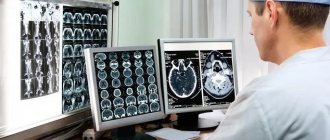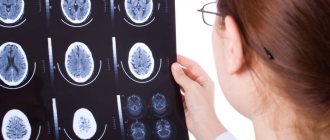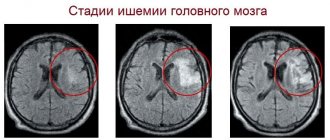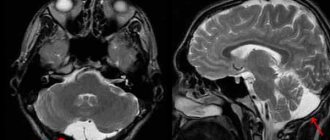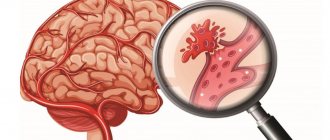The hypothalamus is an important part of the brain. The higher vegetative center carries out complex control and regulation of many body systems. A good emotional state, a balance between the processes of excitation and inhibition, timely transmission of nerve impulses are a consequence of the correct functioning of an important element.
Damage to the structure of the diencephalon negatively affects the functioning of the cardiovascular, respiratory, endocrine systems, and the general condition of a person.
It is interesting and useful to know what the hypothalamus is and what it is responsible for. The article contains a lot of information about the structure, functions, diseases of important structures, signs of pathological changes, and modern methods of treatment.
What kind of organ is this
The diencephalon section influences the stability of the internal environment, ensures the interaction and optimal combination of individual systems with the holistic functioning of the body. An important structure produces a complex of hormones of three subclasses.
Neurosecretory and nerve conduction cells are the basis of an important element of the diencephalon. Organic pathologies in combination with damage to functions disrupt the periodicity of many processes in the body.
The hypothalamus has extensive connections with other brain structures and continuously interacts with the cerebral cortex and subcortex, which ensures an optimal psycho-emotional state. Decortication provokes the development of imaginary rage syndrome.
Infection, tumor process, congenital anomalies, injuries to an important part of the brain negatively affect neurohumoral regulation, interfere with the transmission of impulses from the heart, lungs, digestive organs, and other elements of the body. Destruction of various lobes of the hypothalamus disrupts sleep, metabolic processes, provokes the development of epilepsy, diabetes insipidus, obesity, decreased temperature, and emotional disorders.
Not everyone knows where the hypothalamus is located. The diencephalon element is located under the hypothalamic sulcus, below the thalamus. The cellular groups of the structure smoothly transform into a transparent septum. The structure of the small organ is complex; it is formed from 32 pairs of hypothalamic nuclei, consisting of nerve cells.
The hypothalamus consists of three regions, with no clear boundary between them. The branches of the arterial circle ensure a complete supply of blood to an important part of the brain. A specific feature of the vessels of this element is the ability of protein molecules, even large ones, to penetrate through the walls.
Dietary Tips for Hypothalamic Health
Because the hypothalamus plays such an important role in the body, it is important to keep it healthy. While genetic factors cannot be avoided, there are some dietary steps to take to maintain ideal hypothalamic health.
The hypothalamus controls appetite and is actually influenced by the foods we eat. Research has shown that a diet high in saturated fat can alter the function of the hypothalamus, which regulates hunger and energy expenditure. Sources of saturated fat include lard, meat and dairy products. A diet high in saturated fat has an inflammatory effect on the body. This can affect the immune system, increase inflammation in the gut, and alter the body's natural functioning.
A diet high in polyunsaturated fats, such as omega-3 fatty acids, may help with inflammation. These fats are a safe alternative to other types of oils and fats. Foods high in omega-3 include fish, walnuts, flax seeds and leafy vegetables.
Additional healthy food choices to support the hypothalamus include: vitamin-rich fruits and vegetables, vitamin C, and B vitamins.
The hypothalamus is very important for the body, and we do not notice it as long as it is working normally. These dietary tips will help your hypothalamus work well.
What is he responsible for?
Functions of the hypothalamus in the body:
- controls the functioning of the respiratory , digestion, heart, blood vessels, thermoregulation,
- maintains the optimal state of the endocrine and excretory systems,
- affects the functioning of the gonads, ovaries, pituitary gland, adrenal glands, pancreas and thyroid gland,
- responsible for human emotional behavior
- participates in the process of regulating wakefulness and sleep, produces the hormone melatonin, the deficiency of which develops insomnia and deteriorates the quality of sleep,
- Provides optimal body temperature. With pathological changes in the posterior part of the hypothalamus, the destruction of this zone, the temperature decreases, weakness develops, and metabolic processes proceed more slowly. Often there is a sudden rise in subfertile temperature,
- affects the transmission of nerve impulses,
- produces a complex of hormones, without a sufficient amount of which the proper functioning of the body is impossible.
The table below lists many of these functions and the core groups that are most closely associated with their performance.
| Core | Zone(s) | Region(s) | Functions |
| Paraventricular | Periventricular, Medial | Front, tubular | Fluid balance, decreased milk supply, labor, autonomic control, and anterior pituitary control |
| Preoptic | Medial, Lateral | Front | Lateral anterior thermoregulation, sexual behavior |
| Front | Medial | Front | Lateral anterior thermoregulation, sexual behavior |
| Suprachiasmatic | Medial | Front | Biological rhythms |
| Supraoptic | Medial, Lateral | Front | Fluid balance, milk let-down, labor |
| Dorsomedial | Medial | A tube | Emotion (rage) |
| Ventromedial | Medial | A tube | Appetite, body weight, insulin regulation |
| Arc-shaped | Periventricular, Medial | A tube | Control of the anterior pituitary gland, feeding |
| Rear | Medial | Rear | Thermoregulation |
| Mammillary | Medial | Rear | Emotions and short-term memory |
| Lateral complex | Side | A tube | Controlling appetite and body weight |
Pituitary hormones:
The pituitary gland produces the following hormones:
- Prolactin - ensures the formation of milk during lactation, and also inhibits the production of follicle-stimulating and luteinizing hormones. Numerous other functions (eg, regulation of the immune and nervous systems) are currently being studied.
- Follicle-stimulating hormone - ensures the growth and maturation of follicles in the ovaries of women and spermatogenesis in men.
- Luteinizing hormone stimulates estrogen secretion and ovulation, and in men is responsible for the formation of testosterone.
- Thyroid-stimulating hormone, according to statistics, is the most frequently prescribed hormone for research. Ensures the growth of the thyroid gland and the production of peripheral thyroid hormones - thyroxine and triiodothyronine.
- Adrenocorticotropic hormone - controls the production of hormones from the adrenal cortex.
- Somatotropic hormone is the most important stimulator of protein synthesis in cells, glucose formation and fat breakdown, as well as body growth.
Causes of problems
Damage to the structural elements of the hypothalamus is a consequence of the influence of several factors:
- traumatic brain injuries,
- bacterial, viral infections: lymphogranulomatosis, syphilis, basal meningitis, leukemia, sarcoidosis,
- tumor process,
- dysfunction of the endocrine glands,
- intoxication of the body,
- inflammatory processes of various kinds,
- vascular pathologies affecting the volume and rate of supply of nutrients and oxygen to the cells of the hypothalamus,
- disruption of physiological processes,
- violation of the permeability of the vascular wall due to the penetration of infectious agents.
Complications of hypothalamic syndrome
Treatment of hypothalamic syndrome must be comprehensive and timely, since otherwise various complications may arise. Namely, such complications primarily include:
- gynecomastia (pathology of the mammary glands in men, which is characterized by their significant increase due to tissue hypertrophy);
- polycystic ovarian changes;
- menstrual irregularities (oligo- and amenorrhea, uterine bleeding);
- myocardial dystrophy (secondary myocardial damage, which is caused by various metabolic disorders and is accompanied by tachycardia, shortness of breath, and interruptions in heart rhythm);
- hirsutism (hair growth on the face and body in women of an androgenic nature);
- insulin resistance;
- severe form of gestosis (a pathology in which a pregnant woman experiences swelling, increased blood pressure and the presence of protein in the urine).
Diseases
Negative processes occur against the background of direct dysfunction of an important structure. The tumor process in most cases is benign, but under the influence of negative factors cell malignancy often occurs.
Note! Treatment of hypothalamic lesions requires an integrated approach; therapy is associated with many risks and difficulties.
If oncological pathologies are detected, the neurosurgeon removes the tumor, then the patient undergoes chemotherapy and radiation therapy sessions. To stabilize the functioning of the problem department, a complex of medications is prescribed.
The main types of hypothalamic tumors are:
- teratomas,
- meningiomas,
- craniopharyngiomas,
- gliomas,
- adenomas (grow from the pituitary gland),
- pinealomas.
Hypothalamic disorders
Dysfunction of the hypothalamus is called hypothalamic disease. Hypothalamic disease
It is very difficult to determine because the hypothalamus widely influences the endocrine system. The hypothalamus signals the pituitary gland to release hormones. It is difficult for doctors to diagnose which glands stop working normally; these disorders are often called hypothalamic-pituitary disorders. In these cases, hormone tests are used, which doctors may prescribe, to get to the root of the disorder.
Symptoms
Impaired functioning of the hypothalamus provokes a complex of negative symptoms:
- eating disorders, uncontrolled appetite, sudden weight loss or severe obesity,
- tachycardia, fluctuations in blood pressure, pain in the sternum, arrhythmia,
- decreased libido, absence of menstruation,
- early puberty due to a dangerous hamartoma tumor,
- headaches, severe aggression, uncontrollable crying or fits of laughter, seizures,
- pronounced causeless aggression, fits of rage,
- hypothalamic epilepsy with a high frequency of seizures throughout the day,
- belching, diarrhea, pain in the epigastric region and abdomen,
- muscle weakness, the patient has difficulty standing and walking,
- neuropsychiatric disorders: hallucinations, psychoses, anxiety, depression, hypochondria, mood swings,
- severe headaches due to increased intracranial pressure,
- sleep disturbance, waking up several times during the night, fatigue, weakness, headaches in the morning. The reason is a lack of the important hormone melatonin. To eliminate the disturbances, you need to adjust your waking and night sleep patterns, and take a course of medications to restore the volume of an important regulator. A good therapeutic effect is provided by the drug Melaxen, a new generation drug with a minimum of side effects, without addiction syndrome,
- blurred vision, poor memory of new information,
- a sharp rise in temperature or decrease in indicators. When temperatures rise, it is often difficult to understand what is causing the negative changes. Damage to the hypothalamus can be suspected by a set of signs indicating damage to the endocrine system: uncontrolled hunger, thirst, obesity, increased urine output.
PsyAndNeuro.ru
The hypothalamus is an endocrine gland that controls the work of all other glands, i.e. In essence, it is a regulator of basic processes in the body. It integrates the autonomic nervous and endocrine systems. Located anterior to the cerebral peduncles, the hypothalamus participates in the formation of the wall of the third ventricle and, thus, belongs to the diencephalon.
Hypothalamic hormones have a peptide structure. They are divided into three groups based on the mechanism of action and further path of implementation. The first group includes releasing factors or liberins : corticoliberin, somatoliberin, thyrotropin-releasing hormone, prolactoliberin, gonadoliberin and melanoliberin. Their effect is a positive effect on the trophic cells of the pituitary gland with their further release of the corresponding hormone or tropin. The second group includes statins : somatostatin, prolactostatin and melanostatin. In contrast to the hormones of the first group, they have an inhibitory effect on the hormone-producing cells of the pituitary gland, leading to a decrease in their synthesis of the corresponding active substances. Releasing hormones and statins enter the anterior and middle lobes of the pituitary gland, which are often combined and called the adenohypophysis.
The third group contains the so-called posterior pituitary hormones vasopressin and oxytocin. Synthesized in the hypothalamus, they travel along axons to the posterior lobe of the pituitary gland and are released from there to realize their biological effect. The lifespan of hypothalamic hormones is short, a few minutes, which is of great importance in the precise regulation of endocrine processes, making the signal accurate and quickly amenable to correction.
Corticotropin-releasing hormone (CRH) is synthesized in the preoptic nuclei and stimulates the secretion and synthesis of adrenocorticotropic hormone in adrenocorticotrophs. Contains 41 amino acid residues (read more in the article HPA axis and depression: corticotropin-releasing hormone).
Somatoliberin or somatotropin-releasing hormone (SRH) is synthesized in the arcuate nuclei. In the pituitary gland it affects somatotrophs, stimulating the synthesis and release of growth hormone. It contains 44 amino acid residues (read more Somatotropin & Somatostatin)
Somatostatin or somatotropin-inhibiting hormone is synthesized not only in the cells of the hypothalamus, but also in many other organs. In addition to inhibiting the synthesis of somatotropin, it can act as a neurotransmitter, a regulator of digestion and intestinal motility, cell growth and apoptosis (read more Somatotropin & Somatostatin).
Thyroliberin or thyrotropin-releasing hormone (TRH) is synthesized in neurons of the medial sections of the paraventricular nuclei. Its structure is a tripeptide. In the pituitary gland it affects thyrotrophs, leading to an increase in the content of thyroid-stimulating hormone (TSH). It is released cyclically, approximately at intervals of 30-40 minutes (read more Thyroid hormones and the brain)
.
Prolactoliberin or prolactin-stimulating hormone (PrSH) or prolactin-releasing factor affects lactotrophs, leading to increased synthesis and release of prolactin (read more about Prolactin and hyperprolactinemia).
Dopamine, which is a prolactin-inhibiting hormone, enters the pituitary gland and inhibits the synthesis of prolactin in prolactotrophs. Consists of 56 amino acid residues.
Gonadotropin-releasing hormone (GHR) is synthesized in the preoptic nuclei of the hypothalamus. Entering the pituitary gland, it stimulates gonadotrophs, which leads to an increase in the production of luteinizing hormones (LH) and follicle-stimulating hormones (FSH). It is released cyclically, with a period of about 40-60 minutes; respectively, LH and FSH are released with the same frequency. Consists of 10 amino acid residues. It can also be synthesized in other areas of the central nervous system and act as a neurotransmitter, participating in the regulation of emotional and sexual behavior.
Melanoliberin or melanotropin-releasing hormone (MtRH) and melanostatin regulate the production of melanocyte-stimulating hormone. Synthesized in the middle part of the hypothalamus. They affect the metabolism of proopiomelanocortin (POMC) and consequently the formation of lipotropins, endorphins, etc.
Vasopressin is synthesized in the paraventricular and supraoptic nuclei of the hypothalamus. It enters the posterior lobe of the pituitary gland along axons, from where it is released into the systemic circulation. Consists of 10 amino acid residues. The main effects of vasopressin are associated with the regulation of water-salt metabolism. In addition, it can act as a neuromodulator and neurotransmitter, participating in the formation of behavioral processes. The role of vasopressin in memory formation, regulation of circadian rhythms, locomotor behavior, evaluation of odors and social behavior has been proven. It has a neurotrophic effect, and in some cells of the central nervous system it can prevent apoptosis.
Oxytocin is synthesized in the paraventricular nucleus of the hypothalamus, like vasopressin, and enters the posterior lobe of the pituitary gland, and from it into the systemic circulation. The first to be discovered was the function of the hormone to enhance the contractile activity of the myometrium, which led to stimulation of the birth process, and myoepithelial cells of the mammary glands, resulting in increased milk secretion during lactation. Stimulates the release of prolactin, ACTH and gonadotropins. Oxytocin regulates behavioral activity associated with pregnancy and lactation, shapes social behavior associated with these processes, care for offspring, aggression of males and lactating females, sexual behavior, search for a partner, etc. Oxytocin can weaken social memory and impair learning. However, the effect on cognitive function depends on the dose administered and the type of positive or negative reinforcement training. Oxytocin is involved in stress-induced analgesia, reducing pain sensitivity in critical situations.
Impaired functioning of the hypothalamus is most often associated with tumor processes or circulatory disorders, as well as genetic diseases. Clinical manifestations associated with increased intracranial pressure are headaches, dizziness, decreased vision up to its loss, etc., but it can also be asymptomatic. A decrease in the hormonal activity of the gland is characteristic, which leads to underdevelopment of organ systems in childhood and to their failure in adults. For treatment purposes, radiation therapy and, less commonly, surgery are performed. Hormone replacement therapy is indicated in order to normalize the functioning of the endocrine system. If the synthesis of one of the releasing factors is disrupted, the activity of the corresponding gland decreases. Hyperfunction occurs with a hormone-producing tumor. In this case, there is an increase in the functioning of the peripheral endocrine gland. Rarely, the tumor consists of several types of trophic cells, which leads to dysregulation of several endocrine glands.
Drawing by the author – Zhukova S.O.
Prepared by: Zhukova S.O.
Sources:
1 – Biochemistry: Textbook for Universities / Ed. Severina E.S., 2003, 779 pp., pp. 556-568.
2 – Blagosklonnaya Y.V., Shlyakhto E.V., Babenko A.Yu. Endocrinology: textbook for medical universities / 3rd edition, revised. and additional – SpecialLit. 2012. – 421. : ill. Page 20-28.
3 – Grigorieva M.E., Golubeva M.G. Oxytocin: structure, synthesis, receptors and main effects / J. Neurochemistry. Volume 27. No. 2. 2010 Page 93-101.
4 – Sapin M.R. Anatomy and topography of the nervous system: textbook. allowance / M.R. Sapin, D.B. Nikityuk, S.V. Klochkova. – M.: GEOTAR-Media, 2021. – 192 p. Page 48-49.
5 – Tsikunov S.G., Belokoskova S.G. The role of vasopressin in the regulation of central nervous system functions / Medical academic journal / T.10. No. 4. 2010 Page 218-228.
Diagnostics
Symptoms of damage to the hypothalamus are so varied that several diagnostic procedures need to be performed. Highly informative methods: ultrasound, ECG, MRI. Be sure to examine the adrenal glands, thyroid gland, abdominal organs, ovaries, brain, and vasculature.
It is important to take blood and urine tests, check the levels of glucose, ESR, urea, leukocytes, and hormone levels. The patient visits an endocrinologist, urologist, gynecologist, ophthalmologist, endocrinologist, neurologist. If a tumor is detected, you will need to consult a specialist from the neurosurgery department.
Prognosis of hypothalamic syndrome
Since hypothalamic syndrome is considered a very serious and complex disease, timely diagnosis and treatment are extremely important. In case of delayed diagnosis of the disease, complications for the patient’s body are possible. First of all, these include the appearance of arterial hypertension. In addition, diabetes mellitus and myocardial dystrophy may develop against the background of the syndrome.
Separately, it is worth mentioning the patient’s ability to work, which is determined depending on the symptoms and severity of the disease. In any case, during treatment it is necessary to limit physical and mental stress as much as possible, and also avoid working at night. There is a real possibility of complete loss of ability to work. However, it occurs exclusively in the case of frequent crises, as well as as a result of severe and complicated endocrine diseases. By the way, in such cases, depending on their profession, patients may be assigned disability group III or II.
Treatment
The treatment regimen for hypothalamic lesions includes several areas:
- correction of the daily routine to stabilize the production of melatonin, eliminating the causes of excessive agitation, nervous tension or apathy,
- changing the diet to supply the optimal amount of vitamins, minerals that normalize the state of the nervous system and blood vessels,
- carrying out drug treatment in identifying inflammatory processes with infection with damage to parts of the brain (antibiotics, glucocorticosteroids , antiviral drugs, restorative compounds, vitamins, NSAIDs),
- receiving sedatives, tranquilizers,
- surgical treatment to remove malignant and benign tumors. For brain cancer pathologies, irradiation is carried out, chemotherapy, immunomodulators are prescribed,
- Diet, injections of vitamins that regulate nervous activity (B1 and B12), and drugs that suppress uncontrollable appetite have a good effect in the treatment of eating disorders.
It is important to know why damage to the hypothalamus can lead to a rapid imbalance of physiological processes in the body.
If pathologies of this part of the brain are identified, you need to undergo a comprehensive examination and consult several doctors. With timely initiation of therapy, the prognosis is favorable. Special responsibility is needed when confirming the development of a tumor process: certain types of neoplasms consist of atypical cells.
Learn more about what the hypothalamus is and what this important organ is responsible for after watching the video:
Causes and risk factors
The most common causes of hypothalamic diseases are head injuries. The hypothalamus can also be affected by surgery, radiation, and tumors. In some cases, there may be a genetic link to hypothalamic disease. For example, Kallmann syndrome
(Kalmana) causes hypothalamic problems in children, in which puberty is delayed or absent and the sense of smell is impaired.
Additional causes of hypothalamic disease may include:
Eating disorders such as bulimia or anorexia;
A diet high in saturated fat;
Genetic disorders that cause excess iron accumulation in the body;
Malnutrition;
Inflammation;
Infections;
Excessive bleeding.
Hallucinations, Pickwissky syndrome, Kleine–Lewin syndrome
Hallucinations are false perceptions without a real object. Neuropathologists , neuropsychiatrists and psychiatrists distinguish between visual, auditory, olfactory, gustatory, tactile, and general senses. Hallucinations that occur while falling asleep are called hypnagogic. Hallucinations that occur upon awakening are called hypnopompic hallucinations. Movement disorders in the neuromuscular form of hypothalamic origin, they do not have a clear clinical picture and delineation, they are very variable, unstable, fragmented, and prone to paroxysmal progression. This same form includes some forms of phenocopies of neuromuscular diseases. Disturbances in sleep and wakefulness can be manifested by changes in the sleep formula (drowsiness during the day and insomnia at night), hypersomnia, narcolepsy, periodic hibernation syndrome, which is characterized by sleep attacks lasting from several hours to several weeks. At this time, muscle hypotonia, areflexia, arterial hypotension, and lack of control over the activity of the pelvic organs occur. More complex syndromes of sleep and wakefulness disorders may also be observed: Pickwickian syndrome , Kleine–Lewin syndrome. Pickwickian syndrome is a pathological condition of obesity in small people, manifested by shallow breathing, arterial hypertension (increased blood pressure), shortness of breath, drowsiness and general weakness. Kleine–Lewin syndrome is characterized by attacks of sleepiness with bulimia.
Clinical forms of hypothalamic syndrome rarely occur in isolated form. Thus, vegetative-vascular (vegetative-vascular) crises can be observed in neuroses, diseases of internal organs, vegetative-vascular dystonia (vegetative-vascular dystonia). Neuroendocrine metabolic disorders occur in other pathological processes of non-hypothalamic localization, as well as in primary endocrine diseases.
